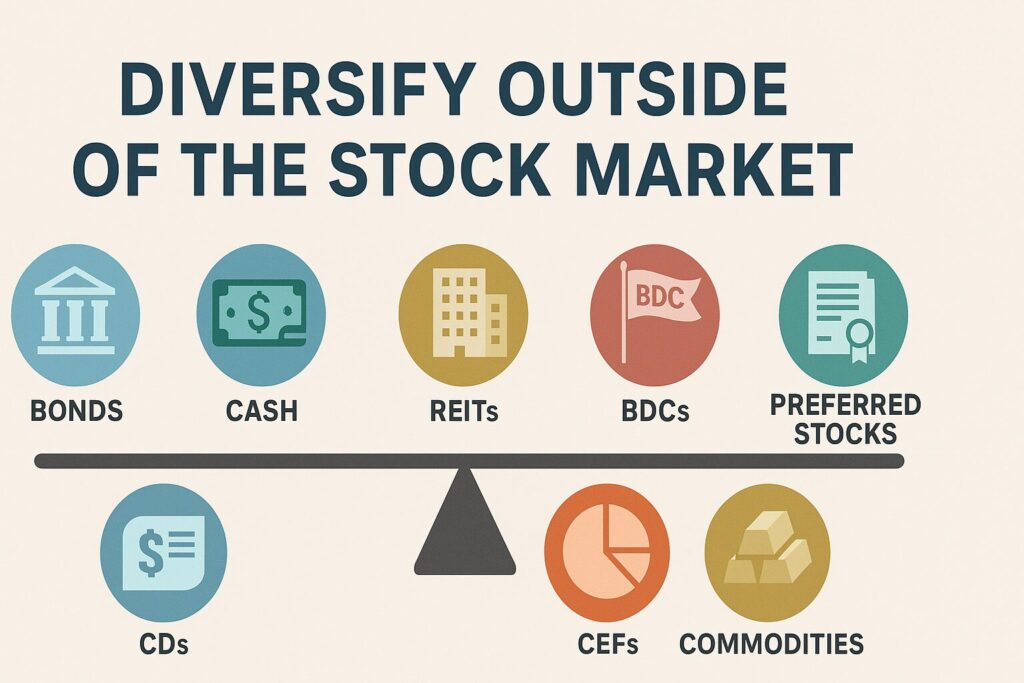
Blend Traditional and Alternative Assets in Your Retirement Portfolio for Greater Stability and Reliable Income
For many retirees, the stock market feels like a roller coaster they didn’t sign up for. And while stocks absolutely have a place in a retirement portfolio, they don’t have to be the whole story.
There’s a smart way to lower your risk, smooth out your returns, and generate dependable income—by diversifying beyond stocks.
In this post, we’ll show you how blending traditional and alternative assets can help protect your retirement savings from market volatility, inflation, and economic surprises—while still offering real growth and income potential.
🎯 Why Diversify Outside of Stocks?
Stocks can be volatile, especially in the short term. Even quality companies can experience sharp price swings due to interest rates, global events, or investor sentiment.
By diversifying into non-stock assets, you:
- Reduce your portfolio’s overall risk
- Create multiple income streams
- Gain stability when markets wobble
- Potentially increase long-term returns
The key is to find the right balance between growth, income, and security.
🧱 Traditional Diversification: Bonds and Cash
Let’s start with the basics.
1. Bonds
Bonds are a classic counterbalance to stocks. While they won’t skyrocket like tech stocks, they offer:
- Predictable interest income
- Lower volatility
- Safety when markets decline
Types of bonds to consider:
- Treasuries: Ultra-safe and government-backed
- Municipal bonds: Tax-advantaged income
- Corporate bonds: Higher yields with moderate risk
- Bond ladders: Spreads out maturity dates to improve flexibility
2. Cash & CDs
Cash may not be flashy, but it offers liquidity and peace of mind. Add:
- Money market funds
- High-yield savings accounts
- CDs (especially for near-term needs)
These help you cover emergencies and provide “dry powder” to invest when opportunities arise.
🌱 Alternative Income-Producing Investments
Alternative investments used to be limited to institutions. Now, they’re widely available and perfect for retirees looking for high income without heavy reliance on stocks.
3. REITs (Real Estate Investment Trusts)
REITs allow you to invest in income-producing real estate—like apartments, medical buildings, and warehouses—without being a landlord.
- Yields often range from 4–12%
- Trade like stocks, but backed by real assets
- Diversify your income with inflation protection
Look for:
- Equity REITs (own property)
- Mortgage REITs (own loans—higher yield, more risk)
- REIT ETFs for broad exposure
4. BDCs (Business Development Companies)
BDCs lend money to small- and mid-sized businesses. In return, they pay high dividends, often 7–10% or more.
- Traded on the stock exchange
- Strong yields, often monthly
- May fluctuate with credit conditions
They’re a good way to gain access to private credit markets, which aren’t typically available to individual investors.
5. Preferred Stocks
Think of these as a hybrid between stocks and bonds.
- Pay fixed dividends
- Ranked above common stock in a bankruptcy
- More stable than common shares
- Often yield between 5–7%
Preferred stock ETFs can help you diversify across many issuers with one click.
🔄 Non-Traditional Alternatives for Retirees
6. MLPs and Energy Infrastructure
Master Limited Partnerships (MLPs) invest in oil and gas pipelines, terminals, and storage facilities.
- Offer 8–10% yields
- Backed by long-term contracts
- Tax-advantaged income (often partially tax-deferred)
Note: MLPs are better held in taxable accounts due to special tax treatment.
7. Closed-End Funds (CEFs)
These funds often invest in bonds, loans, or REITs—and they frequently offer high distributions, sometimes 8–10%+ annually.
- Trade at a discount or premium to net asset value
- Active management allows for niche strategies
- Great for retirees looking for monthly income
Just be sure to understand the risks: leverage, fees, and volatility can vary.
🌍 Real Assets for Inflation Protection
8. Commodities and Gold
Gold and commodity-focused funds don’t pay dividends, but they hedge against inflation and currency devaluation.
- Gold ETFs for safe haven exposure
- Commodity funds for broad inflation protection
These are useful for diversification and long-term stability—not income.
9. Farmland and Timberland (via Funds or REITs)
These assets are uncorrelated with stocks and offer long-term appreciation.
- Farmland REITs generate rental income and crop profits
- Timberland funds grow trees—literally—for future harvest
They’re slow and steady growers with low volatility.
💼 A Sample Diversified Retirement Portfolio
Here’s an example of a well-diversified portfolio that blends traditional and alternative assets:
Stable Income Retirement Mix (for a moderately conservative investor)
- 25% High-Quality Bonds (Treasuries + Munis)
- 20% REITs
- 15% Dividend Growth Stocks
- 10% BDCs
- 10% Preferred Stocks
- 10% Closed-End Funds
- 5% Cash/CDs
- 5% Gold or Commodities
This portfolio aims for a 5–6% income stream with lower risk than a 100% stock portfolio—while still growing over time.
✅ Tips for Adding Alternatives to Your Retirement Plan
- Start small—add 5–10% in one or two categories
- Use ETFs or mutual funds to diversify quickly
- Focus on income consistency, not just the highest yield
- Rebalance annually to stay aligned with your goals
- Keep some liquidity (cash or CDs) for unexpected expenses
🧘♂️ Peace of Mind Through Diversification
When you diversify outside of the stock market, you create a portfolio that can weather different economic environments. Inflation, rising interest rates, recessions—none of these will knock you off course if your plan is built on multiple pillars of income and stability.
You don’t need to abandon stocks. Just blend them with other sources of income that are steadier, more predictable, and less likely to give you gray hair every time the market dips.
📘 This post is adapted from my book:
The 9% Retirement Paycheck: How to Generate Steady, Worry-Free Income for Life
Available now at Amazon.com in paperback and eBook formats.
Disclaimer: This article is for informational purposes only and does not constitute financial, investment, or tax advice. Always consult a licensed financial professional before making any investment decisions. Investment returns are not guaranteed, and all investments carry risk.